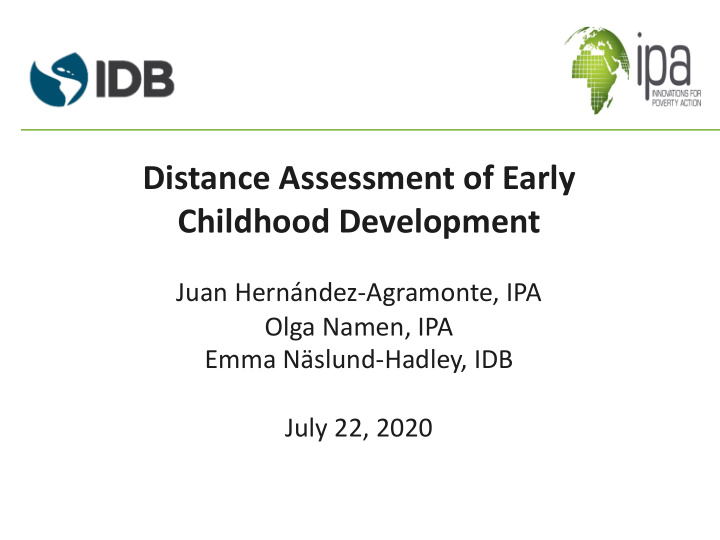



Distance Assessment of Early Childhood Development Juan Hernández-Agramonte, IPA Olga Namen, IPA Emma Näslund-Hadley, IDB July 22, 2020
Context • Lockdowns à disruption of educational/care services à learning loss • Distance learning strategies “ Aprendo en Casa” (AeC) • Partnered with Ministry of Education of Peru • Survey to monitor take-up and use of AeC • SMS intervention to support parents during homeschooling • Can learning outcomes be measured over the phone?
Main takeaways 1. Qualitative evidence of the feasibility of using distance assessments to measure early childhood development 2. The mode of administration (video vs. audio) imposes restrictions on the domains of knowledge that can be assessed 3. Caregivers play a key role in the implementation of these assessments
Our project Main objective Design and validate a distance assessment test to be administered remotely on preschool children aged 4-6 years old Mode • Develop two parallel forms of the questionnaire based on households’ device type: audio (phone) or video (smartphone) Sample • Pilot on two different samples in Colombia and Peru (approx. 3000 children)
Questionnaire design Constructs of interest • Math skills: counting, comparing numbers, addition, subtraction, spatial sense • Literacy skills: letter/sound identification, listening comprehension, expressive vocabulary • Socio-emotional development: empathy, conflict resolution Adapting existing tests • Measuring Learning Quality and Outcomes (MELQO) • Early Grade Mathematics Assessment (EGMA)
Some examples Skill Original item Adapted item (audio) Adapted item (video) Please count out loud Counting numbers Same as original Same as original starting from number 1 Name food items and Expressive vocabulary Same as original Same as original animals Show image of a girl Tell the story of a girl who has fallen to the who has fallen to the floor floor Empathy Same as original Ask: “How do you think Ask: “How do you think the girl feels?” the girl feels?” Show several images to Ask about general Show one image to the the child reference points child Spatial sense Ask: “Point to the image The sky is (above, Ask whether the ball is where the ball is above below, in front of…) your (above, below, in front a chair” house of…) the chair Drawing Motor development - - Physical activities
Feasibility study • Piloted the assessment in 18 households located in different regions of Peru Piura (4) • Qualitative surveys to parents San Martín (2) • Assessment scheduling call La Libertad (1) Lima (10) Junín (1) • Protocol validation • Implementation quality
Mode In Peru, 89% of the population with internet access connects through smartphones Audio Unilateral video Bilateral video Mode Phone call App based call App based call Visual aids No Yes Yes Enumerators can see the No No Yes child The child can see the No No Yes enumerator
Example using bilateral video: [Enumerator]: Using your hands could you please show me eight fingers?
Main lessons 1. The mode (video vs. audio) imposes restrictions on the domains of knowledge that can be assessed Audio Video Math 4 6 Communication 3 5 Socio-emotional 3 3 Executive function - - Motor development - - Total 10 14 Challenges: 1. Items that include visual aids and non-verbal responses 2. Limited attention span
Main lessons 2. Caregivers play a key role in the implementation of the remote assessments • Early childhood assessments in person require support from teachers and principals • Caregivers’ role: • Scheduling the test at home • Signing informed consent • Following test instructions • Monitoring quality of audio/video during the test • Strategies to mitigate caregivers’ involvement during the test
Main lessons 3. Overall, there is qualitative evidence of the feasibility of using distance assessments to measure early childhood development • Time was adequate: audio (21 min), video (24 min) • Children understood instructions and answered the questions • Parents reported they were satisfied with the test “[my son] was comfortable and engaged with the test, it was like a game for him” • Great potential (at low cost) to monitor outcomes during COVID-19 lockdown and to complement in-person assessments in the future
Next steps: ongoing piloting Reliability and validity • Test-retest correlation, internal consistency across items • Criterion validity using existing baseline data collected in person in 2019 • Compute difficulty index, discrimination index, global item analysis (ceiling/floor effects) Mode effects • Measure the impact of different modes of surveying (audio and video) • Households with internet access will be randomly assigned to either audio or video surveys
Thank you poverty-action.org
Recommend
More recommend